how to Buy a Sewing Machine
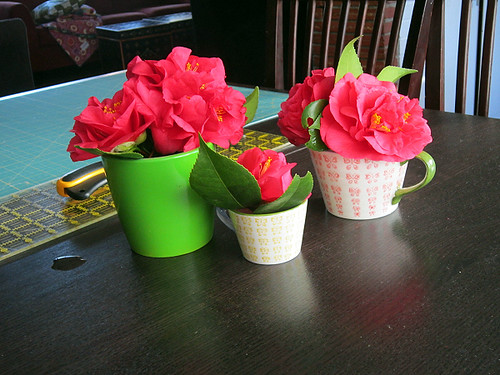
Thank-you SO much for your feedback on sewing machines. Although it can be overwhelming at times, hearing from so many of you drove home a few key concepts:
1. Everyone has different needs and different experiences. Maybe 4 people LOVE sewing machine X, but 3 others say they had nothing but problems with the exact same machine. My thought is that there are "lemons". Sewing machine X may be a wonderful, reliable machine if assembled properly. But, due to quality control issues or maybe because it was dropped a few extra times between China and the states, sewing machine X may be your worst nightmare. This is the only logical explanation to me when people I know and respect report opposite experiences with the same machine.
What do you do about the possibility of lemons? Well, if you buy in person, you can try out the machine you'll be taking home to see how it performs in store. And, if you have a local dealer you can rest on the warranty for free repairs within a year of purchase in most cases. Many dealers will also let you trade up for a different machine if you decide the one you purchased is awful. In contrast, if you buy from Ebay sight-unseen, even a new-in-box machine may mean lots of trouble... or not. It's a gamble that way. You can save lots of money on Ebay, but that machine is yours.
2. Consider buying used. So many of you suggested I buy a used machine so that I could invest in a higher quality machine than my budget would allow if buying new. Smart! Since many dealers do allow trade ins, they may have a few used machines to consider. You might also find used machines locally through Craigslist, which would allow you to try before you buy. Especially if you decide you want to own a Bernina, used is a great way to go as testified by many, many commenters.
3. The best way to compare machines is to test drive! I'm so glad that you all pointed that out. I wouldn't have thought to take the 2 hour drive to Charlotte Sewing Center to test drive machines if you hadn't suggested it. For anyone else trying to sort out which machine you want, I cannot recommend highly enough that you go test drive. It's worth it. So worth it! Bring a selection of sewing samples, from simple piecing to bulky seams to quilt sandwiches for straight line and free motion quilting.
and then I Went Shopping
On Friday I left my kids with my mother-in-law and journeyed with my mom to Charlotte to spend the day shopping. Priceless! I also took my broken Kenmore along to Charlotte Sewing Center, where Mr. Bill repaired the machine while I shopped. My mom called him the sewing machine wrestler. It was impressive to see him at work! This guy is serious and good. Seriously good. I won't be taking my machines anywhere else. There were other people at the store on Friday from my hometown (2 hours away) and Alabama (8 hours away). His store has a reputation for buying and for repairs.
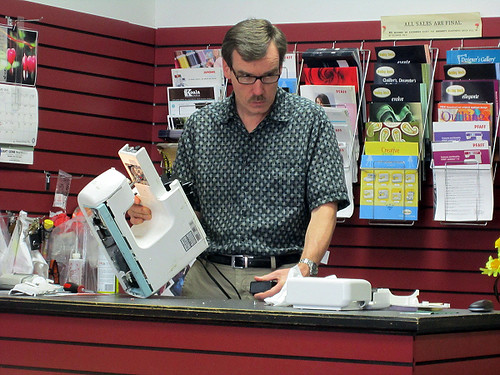
After combining your comments on SOS Sewing Machines with my own research, here are machines of interest:
Juki TL98Q ($1000)
Juki TL2000Q ($865)
Viking Sapphire 835 ($1000)
Babylock Serenade ($1300)
Pfaff Ambition 1.0 ($800)
Pfaff Expression 4.0 ($2100)
Janome 1600P ($800)
Janome Memory Craft 6600 ($1500)
Janome Horizon ($2800)
used Bernina?
Many of these are above my spending limit of $1000, but perhaps I would buy them used or on Ebay if I really fell in love. Also, it seems wise to shop a little bit above your limit to make sure that you don't want to save until you can spend more. Some key new features for me are:
*Dual feed/built-in walking foot. With my Kenmore I found that most projects were improved by using a walking foot. Without it, if I was piecing long sashing strips I would see that the top fabric was not keeping up with the bottom fabric as they feed through the machine. As a quilter, I also need a walking foot for quilting and binding. With a separate walking foot I cannot use other feet (like a quarter inch foot) in conjunction with a walking foot. Plus, separate walking feet are NOISY. I am also hoping that a built-in walking foot will be more effective.
*Large harp space. The space under the arm of the sewing machine and to the right of the needle is called harp space. I want to buy a machine with at least 8" to make quilting easier.
*Good for Free Motion Quilting (FMQ). My Kenmore had tension issues when I FMQed. A higher quality machine should do better.
Some features my Kenmore has that I wouldn't want to do without: needle up/down, speed control, accessory tray, good lighting, needle threader and free arm. I could imagine not having as many stitch options or auto buttonhole, since I could rely on my Kenmore for those rare occasions.
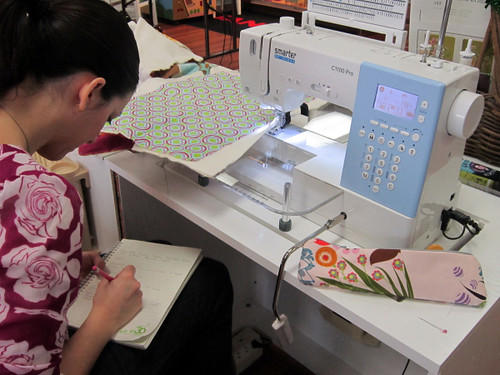
So, Charlotte Sewing Center represents Pfaff, Janome, Babylock and Viking. Juki's website listed the store, but it turns out Bill had just sold his last Jukis weeks before. He won't be restocking Juki because it's not selling well in comparison with the other machines that do more than straight stitch. I was bummed because a lot of you really love your Juki. Most quilters only use straight stitch. Juki's are semi-industrial machines with long arms that are reported to be great at FMQ too. Bummer.
Charlotte Sewing Center also didn't have the Viking Sapphire. There were quite a bit of mixed reviews on this machine in your comments, so it was not a strong contender for me. I don't recall that he had any non-embroidery Vikings, actually. I didn't end up trying Viking or Babylock.
Sewing Machine Comparison
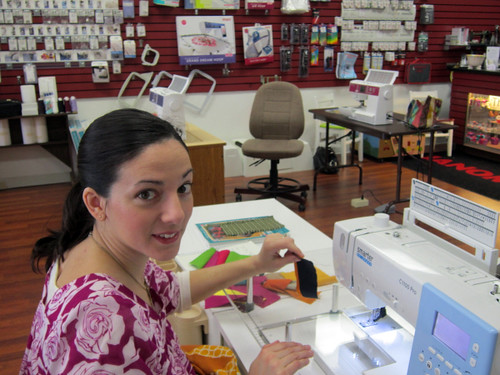
These are just my personal experiences. I recognize that any issues I had may be a result of user error or of a faulty machine. I brought lots of samples and took notes as I went. Here are my thoughts in the order I tried them...
Pfaff Ambition 1.0
This was the machine leading the pack in my mind, so I tried it first. With 8" of harp space and built-in dual feed a $800 price tag, it seemed like a good buy. The Ambition handled the exact same bulky drapery seam that had tanked my Janome days before with aplomb. In fact, all of the Pfaff machines couldn't care less if I was sewing through thick or thin fabrics, bumps or not. The Ambition does not have these nice features: knee lift, auto thread cutter, auto tension adjustment. When I FMQed on the Ambition my work showed tension pulls from the back. It wasn't as bad as what happens on my Kenmore and possibly changing the tension would fix it. I didn't ask Bill to help me with that.
For the price difference, I did not try the Ambition 1.5. At $200 more you get more stitch functions and a bobbin sensor to alert you when its running low. Neither are important to me.
Pfaff Smarter 1100 Pro
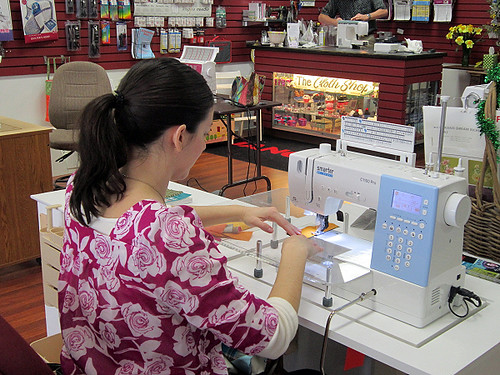
I had not considered this machine, but Bill had it set up with a lovely, huge extension table. Like all upper-end Pfaff's it has built-in dual feed that feeds from the back with a black arm. Dual feed can be disengaged if desired. It works with 6+ presser feet, including the 1/4" foot.
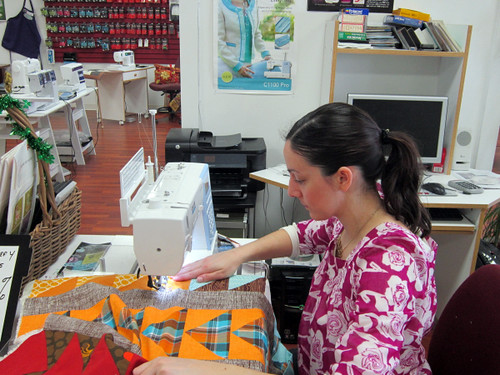
The Smarter a semi-industrial machine, which means it's made with more metal than other Pfaffs and has other built-to-last features like all metal rotary vertical bobbin and a 2nd motor for bobbin winding to reduce wear on the main motor. For $1500, it has a 9" harp, a wider stitch width than non-industrial machines (nice for spacing straight line quilting), two thread spool or cone holders and a ton of stitch functions. I could feel that it sews faster than other machines too, with 1100 stitches per minute. It was easy to tell that the machine was stronger since it doesn't vibrate when sewing.
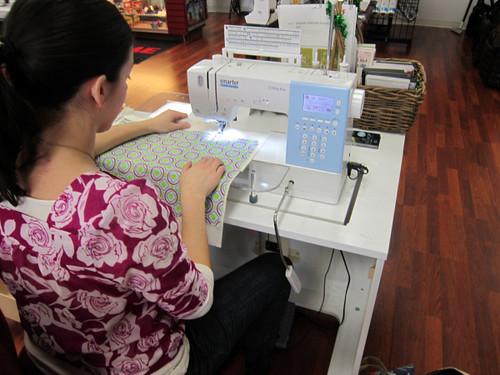
Smarter also has some features that are nice "extras" for me: auto thread cutter, low bobbin sensor, and knee lift. Only when I tried the knee lift I decided it was a MUST for me. Wow, does that save time! The knee lift allows you to lift the presser foot hands free.
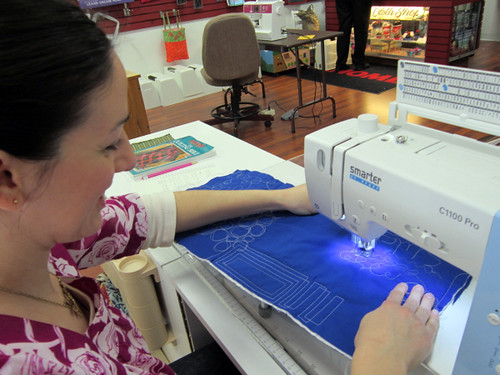
When I free motioned on Smarter the thread tension on the back was perfect. That's because this machine has auto tension adjustment, which senses how thick your fabric is and adjusts tension accordingly. You can manually adjust tension if desired. The Quilter's Toolbox for this machine lists at $250, which includes the extension table, FMQ foot, several 1/4" feet and other feet. Always ask the dealer to throw in accessories when you buy.
Pfaff Expression 4.0

This is Pfaff's top-of-the-line for quilters with a 10" harp space for $2100. Of course it has dual feed and all of the features of the previous Pfaffs. In addition it has Auto Pivot. This is fun. Really, really fun. When you stop sewing on this machine the presser foot automatically lifts and the needle stays down. Those two things in combination means you can easily turn when quilting. I tested this out with some concentric squares on my quilt sandwich and then couldn't stop. I started doodling in geometric shapes. SO FUN! I could see how this alone will sell the machine. However, this machine did vibrate a lot as I sewed. Also there is a little dip in the work surface just before the bobbin area that has been reported to flip seam allowances, causing mayhem. I could see how that could happen, though I didn't have the right materials to test it myself.
I did not consider the Expression 3.0 (cheaper) because it has no knee lift or auto pivot.
Janome Horizon
I was very excited to try this machine. It's so pretty! With a 11" harp space, it's huge. The Horizon has lots of features, so I'm going to focus on what it didn't have that I had appreciated so far. It did not have auto pivot, but costs $2800. The machine seemed to sew a tad quieter than the Pfaff's, but it did vibrate like the Expression.
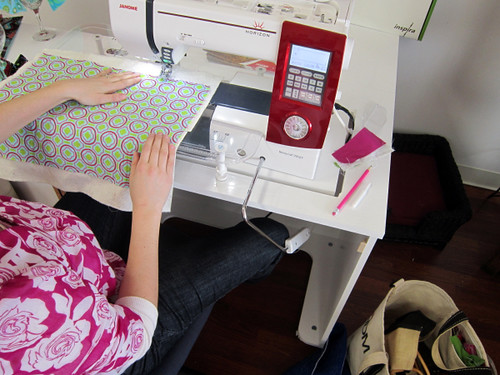
It did have a knee lift, but it was WAY to far to the side. Here's how far I had to move my leg to reach it. Ouch! (edited to add: The knee lift is straight up and down when you go to press it, but I had to press it that much to really clear the foot presser from the fabric. In contrast, the Pfaff knee lift starts out angled in so that when you press it, you go to about vertical for lift off.) I asked Bill if the knee lift was adjustable; it's not. For control you want to center your body in front of the needle while you sew. With this machine, I just wouldn't be able to use the knee lift. That was a big downside since even just a little sewing yesterday showed me how much I would enjoy that feature. For comparison, this is how far my leg has to move to the side with the Smarter:

Unlike the Pfaff's (which invented dual feed), the Horizon has dual feed built into the main foot. Pfaff's have a separate black lever for the dual feed that reaches down in back of the foot. The Horizon foot that has dual feed is called an "Accufeed" foot. This foot is extra wide and only available in normal and in the 1/4" foot (about $30). So, really... it seems more like a walking foot that comes standard than built in dual feed? It's kind of a matter of perspective. Anyways, I started off wanting to chain piece some fabrics. Here I'm feeding them into the machine...
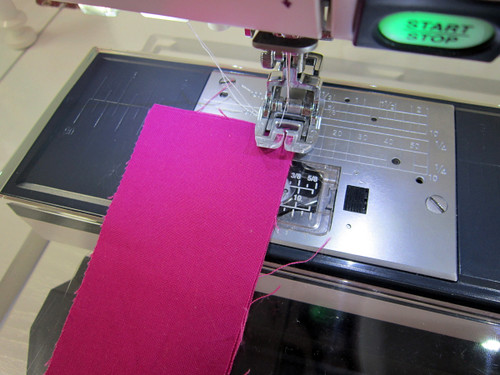
And, the Accufeed foot is causing problems. This foot has a gap in the center that opens and close as it pulls the fabric through. My seams consistently bunched up in that gap over and over and over and over again.
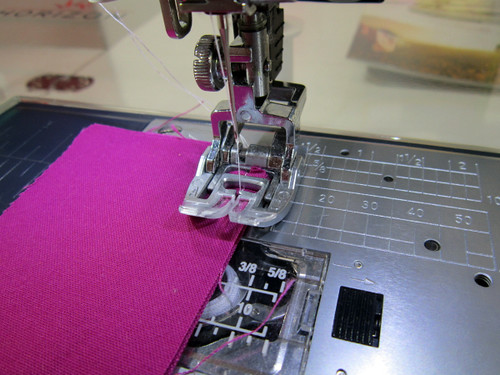
Even though Bill was busy, I called him over to show me what was going wrong. He gave it a new needle. She would sew without bunching if you started in the center of the fabric or a long ways in from the top, but every single time either Bill or I fed fabric for a 1/4" seam starting even a 1/2" in from the top, the fabric bunched. Wouldn't even keep sewing either because the bunching jammed it up.
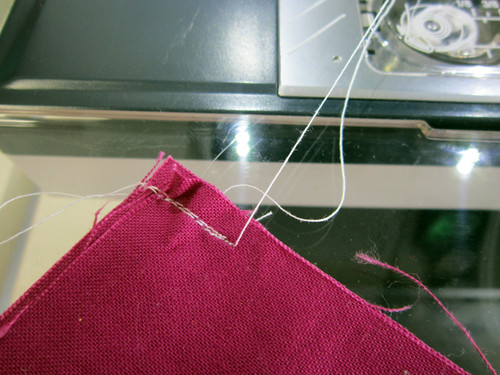
Perhaps a potential fault of the Accufeed foot design itself? It seems impossible that everyone has this problem (which would completely prevent chain piecing) because I know many love their Horizon, so I feel like the foot at the store must be defective.
Janome Memory Craft 6600/Janome 1600P
Unfortunately, Charlotte Sewing Center did not have other upper-end quilting Janomes. However, the 6600 ($1500) has the same walking foot as the Horizon - the Accufeed - and the 1600P ($800) would have required a separate walking foot. I've heard good things about these machines and would have liked to try them.
Babylock Serenade
This machine was at the store, but I didn't end up trying it. I was pretty much there all day and was starting to tire out! At $1300 it looks a lot like the Ambition, which runs $800-1000. In features it's somewhat between a Pfaff Ambition and their Expression. Could be worthy of considering.
Bernina Artista 635
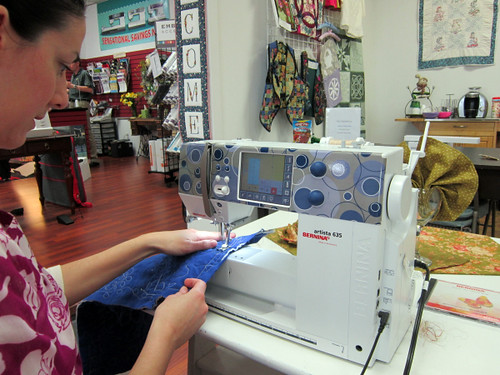
The last machine I tried was this Bernina. Bernina's are the only machines still made in Europe and mostly of metal. It's heavy and it doesn't vibrate. Bill is selling this used machine for around $2300. It has a very, very small harp space (as small as my Kenmore). And, this is the case with ALL Bernina's except their most expensive machine, the Bernina 8 series (820/830). The 8 series have gigantic 12" harp space, but retail around $10,000 new. Even purchased used, a Bernina with harp space is out of my price range.
So, that's the story! Nope, no "answer" just yet. Shopping in person was a GREAT IDEA and as a bonus my old Kenmore is now working like a dream. I highly recommend Charlotte Sewing Center to anyone in the area!
***Addendum***
Not long after my shopping trip, I bought a Pfaff Smarter sewing machine. Although it was nice for awhile, soon it started malfunctioning with various computer errors. I had it serviced and repaired several times before deciding to move on. Now I've been sewing on a Juki TL 2010Q for years. I absolutely love my machine, which is non-computerized (i.e. very durable) and ideal for piecing and quilting. You can read more about my Juki here. This is the machine I recommend to most looking for a high quality home quilting sewing machine!
